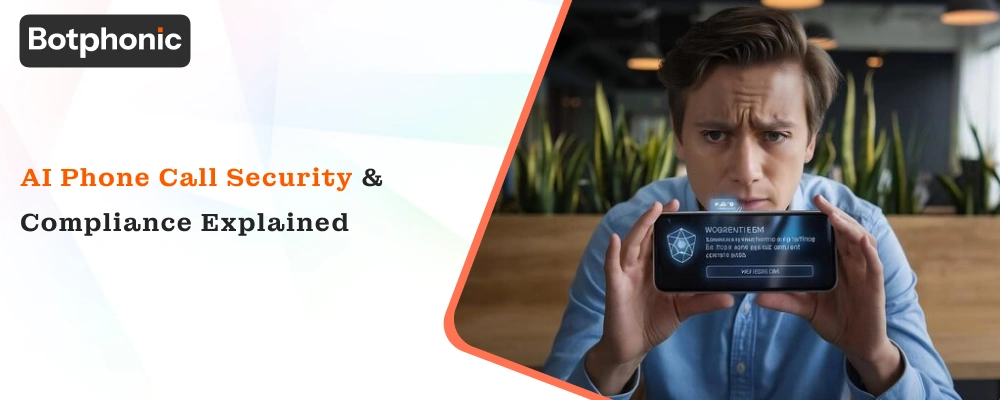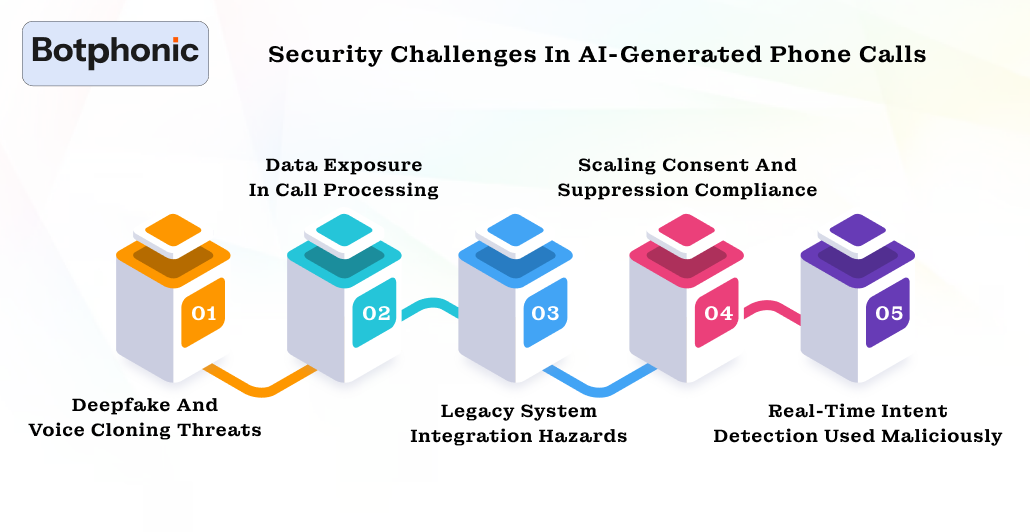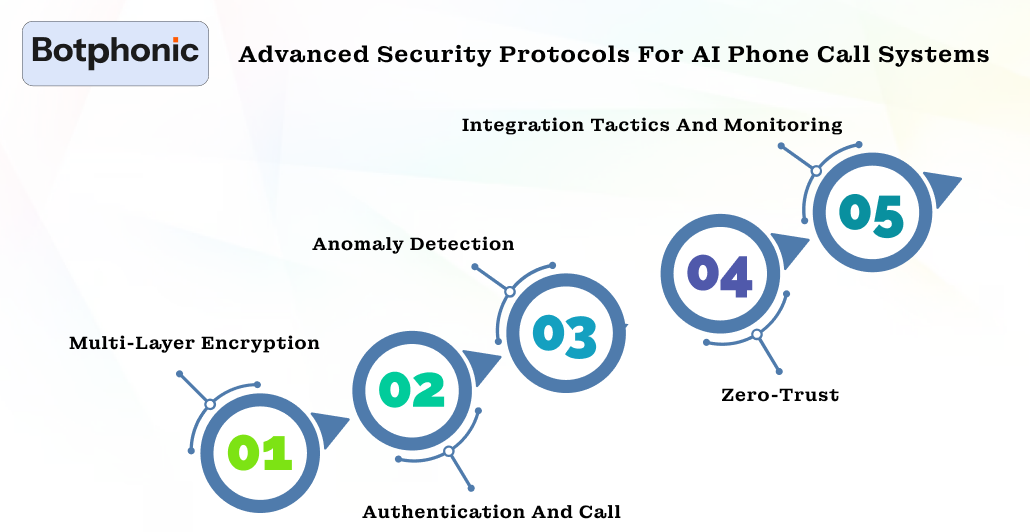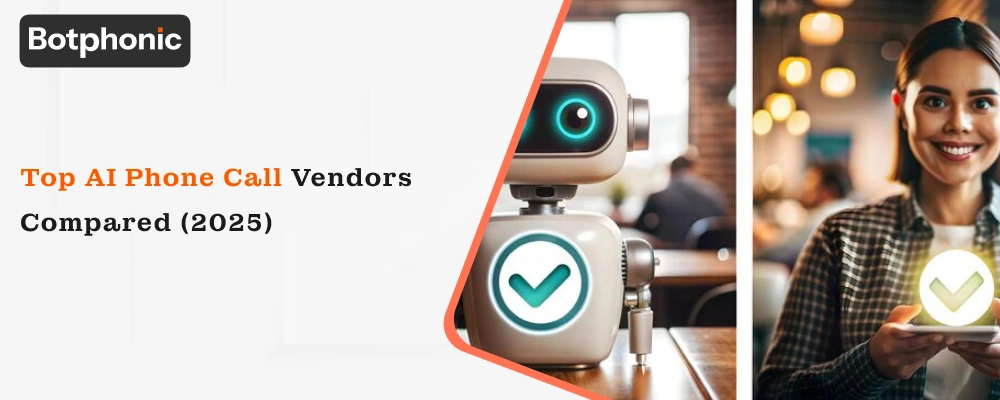
Summarize Content With:
Quick Summary
AI-driven voice technology is revolutionizing enterprise communication, that is powering AI call assistants, AI sales phone calls, and automated voice workflows that also analyze customer intent in real-time. But, along with this evolution, it also brings an urgent focus on AI phone call security and compliance.
In this article, we will discover the practical technical details how enterprises should approach deploying and governing AI-powered voice systems, from architecture to audit trails, and from intent analysis to consent frameworks.
Introduction
Enterprises today have shifted from “we have inbound voice systems” to “we have AI-driven outbound and inbound voice agents”, which is powered by AI phone call technology. Enabling AI call assistant capabilities, AI sales phone call workflows, and real-time AI analysis of phone call content, and customer intent intelligence. As boards and CIOs allow these systems, one question rises to the top: how do we guarantee AI phone call security and compliance?
The stakes are really high; a single non-compliant voice agent, or just an improperly managed AI-generated phone call, can easily expose the business to regulatory fines. Meanwhile, the upside is miraculous: there are faster sales qualification, richer CX, and deeper insights.
The Core Mechanics of AI Phone Call Technology
To secure and comply with AI voice systems, one must know how they work behind the scenes. Let’s uncover the technical architecture of an enterprise deployable AI call assistant.
1. Voice Input, Speech Recognition, and NLP
When there’s a prospect dialer or when the system places an outbound call, the call media is captured. Real-time STT engines proactively engines and convert the audio into textual transcripts. Moreover, NLP modules start to classify the intent or just route them accordingly. It enables the system to perform AI analysis of phone call content and customer intent.
2. AI Voice Synthesis and Automation
On outbound workflows, the system leverages TTS engines or even voice-cloning modules to generate fluent voice responses. The AI assistant phone call feature might just dynamically create the scripts. Then it executes the decision trees for lead qualification or support. Some systems even support AI voice changer phone call functionality to adapt tone or language for business localization.
3. Data Routing, CRM Integration, and Analytics
All voice calls, either inbound or outbound, are fed into the enterprise platform: call metadata (such as caller ID, timestamp, number, etc), transcript data, intent scores, and audio recordings. These links to CRM or any other analytics warehouses. That’s how the AI sales phone call funnel becomes measurable: you map voice-call outcomes to conversions, pipeline, and revenue.
4. Why This Matters for Security and Compliance?
Each step, including voice capture, processing, transcriptions, storage, and integration, is a potential risk vector. There are unprotected media streams, naive consent capture, and unclear, ambiguous retention policies. They all threaten AI phone call security compliance. Without having a vigorous architecture, the chosen AI voice system becomes a regulatory liability.
Security Challenges in AI-Generated Phone Calls

When AI is introduced in telephony, it also presents new and complex security challenges. Let’s discuss them each in brief:
1. Deepfake and Voice Cloning Threats
With AI-generated phone call capabilities, vicious actors can just impersonate a trusted voice or spoof numbers. Research indicates voice-cloning systems have now become convincing enough to avoid human detection. This also means that an outbound voice agent could just be mimicked to deceive their known ones, or the system can just get hijacked to send fake calls.
2. Data Exposure in Call Processing
Voice recordings, transcripts, and intent analysis results are all composed of sensitive data. If these data files are stored insecurely, mis-retained, or unencrypted, you are just exposed to threats. Enterprise platforms have already flagged this as a key risk: “End-to-end encryption, real-time PII detection and redaction, audit logging” are non-negotiable. This concept is simple yet many times ignored: audio + transcripts = personal data + risk.
3. Legacy System Integration Hazards
Many organizations are adding “AI phone call automation” on top of legacy PBX, SIP trunks, and CRM systems. It effectively creates blind spots, such as outdated telephony gear may inflict weak authentication, open access, or manual intervention risk.
4. Scaling Consent and Suppression Compliance
Outbound calls typically require strict consent and suppression. With AI, calls can scale tens of thousands every day. Without strict consent tracking, deletion workflows, and queuing for opt-out lists, you are just exposed to major regulatory issues.
5. Real-Time Intent Detection Used Maliciously
Even when used appropriately, “AI analyzes phone call content customer intent” engines can easily be optimized maliciously, such as phishing or spear-phishing campaigns, if controls are loosened. The platforms should ensure that they are offering role-based control, anomaly detection, and fraud-prevention built in
Compliance Frameworks Governing AI Phone Call Systems
Let’s get real with this situation. Security is a technical concept, but compliance is legal and regulatory. Your AI voice automation must satisfy both concepts without failing.
1. Regulatory Overview
implementing the same technical and organizational measures for data protection as you do).
- In the US, the Federal Communications Commission (FCC) through the Telephone Consumer Protection Act (TCPA) regulates among outbound calls, robocalls, AI-generated voices: one has to get prior express consent for autodials, disclose AI use.
- In Europe, the General Data Protection Regulation (GDPR) deals with voice data (personal data; one has to guarantee data minimisation, suitable retention, and secure storage.
- In the medical field, the Health Insurance Portability and Accountability Act (HIPAA) becomes applicable if voice systems deal with Protected Health Information (PHI).
- dialzara.com
- In the financial transactions area, the PCI DSS (Payment Card Industry Data Security Standard) comes into play when IVR/voice systems take card data through the capture of voice.
2. Major compliance controls for AI phone calls
- Permission acquisition and monitoring: Informed consent for outgoing AI-powered calls must be obtained (“This call is using AI and may be recorded…”).
- Call recording guidelines & duration: If a call is recorded, there should be a policy stating (who records, why, where it is stored, and how access is controlled). Recorded audio + transcript = regulated data.
- Notification of AI application: In some places, you are required to clearly inform that the voice agent is AI, not a person.
- Secure storage, encryption & anonymization: All voice data should be encrypted while being transferred and kept, should have access controlled possibly through tokenization.
- Suppression/Do Not Call compliance: The systems must operate lists of those who do not want to be called, those who opted out, calling limits, and prohibition checks all before making a call.
- Audit trail & access based on roles: You have to keep track of who accessed what, when, and why, especially in regulated sectors.
- Third-party/Sub-processor management: In case you are using a third-party AI voice call platform, you must make sure they provide compliance guarantees (for example, applying the same level of technical and organizational measures for data protection as you do).
Advanced Security Protocols for AI Phone Call Systems

Let’s learn how to build or evaluate the infrastructure underpinning a fully secure AI phone call system:
A. Multi-layer Encryption and Processing Architecture
- Transit Encryption: Optimize TLS 1.3 or any other equivalent for SIP/VoIP/HTTP streams between endpoints.
- Storage Encryption: Leverage ES_256 at rest for audio and transcript files. There are platforms that apply tokenisation for fields that are sensitive, such as card numbers or SSNs in transcripts.
- Processing Safeguards: Verify that mid-processing systems are operating in isolated environments with access control and logging.
- Redaction Pipelines: Before long-term storage, ensure to apply PII redaction or transformation.
B. Authentication and Call Origin Verification
- Ensure to implement STIR/SHAKEN or other equivalent protocols that verify caller identity and mitigate spoofing.
- Implement voice-biometrics or call-fingerprinting that helps authenticate known callers.
- For outbound campaigns, throttle pacing, ensure to monitor patterns such as volume spikes, call duration anomalies, that help detect misuse or compromise.
C. Real-time Intent and Anomaly Detection
- Build or subscribe to modules that help perform AI to analyze phone call content and customer intent in real-time. For instance, detecting when a voice agent is disclosing personal data where it shouldn’t, or even when a call diverges from the authorised script.
- Add anomaly detection models that spot unusual call durations, repeated opt-out prompts, or even high error rates, which alert to potential fraud or misuse.
D. Zero-Trust Within Voice Environment
- Treat the voice stack as you would your zero-trust network; suppose there’s no component that is trusted by default. Segment call processing, route analytics, and storage separately as well.
- Use identity and access management for agents, transcripts, and data exports. Ensure to enforce least privilege.
- Apply MFA for administrative access and segregation of duties for script changes.
E. Integration Tactics and Monitoring
- Integrate your voice AI platform with a security information and event management (SIEM) system. Log calls, transcripts, consent events suppression checks, etc.
- Create dashboards for compliance officers, for instance, call volumes, AI-agent usage, opt-out rates, retention ages, and call-logging status.
Book a compliance audit with our voice-AI security specialists.
Try Botphonic Demo Today!!AI Ethics and Transparent Communication Standards
Ethics and transparency are one of the critical matters that should be followed by organizations.
1. Disclosure: Human vs AI
There are many regulators that requires disclosure when an interaction is made with an AI agent. Organizations must at least make it clear: “You are interacting with an automated voice assistant.”
2. Respecting Customer Intent and Consent
Your AI sales phone call or AI assistant phone call feature should always respect users’ preferences: if the user wishes to speak with a human, it must escalate seamlessly. Ethical automation is automation with escape broods.
3. Fairness, Bias, and Inclusivity
The voice-AI should support multiple languages, such as AI phone: phone call translate features, accents, and avoid bias. It should treat all the customers equally, which matters from both ethics and brand reputation perspectives.
4. Use-Case Scope and Limitations
AI voice agents are really powerful; however, one should draw clear boundaries. For example, sensitive financial advice or legal counsel via voice-AI may require human supervision. Ensure to document these boundaries. Over-promising creates one of the legal and reputational risks.
5. Training and Transparency Logs
Ensure to maintain all the audit logs, not just for compliance but for transparency as well. With this, you can verify the voice model that was used, the version, and what learner data was included. Moreover, it also verifies which intent classifiers were triggered. It also helps in trust audits and incident investigations.
Conclusion
AI phone call system have introduced themselves firmly, but it’s not enough just to automate them; one should automate responsibly. Every AI-generated phone call carries dual obligations: to protect privacy and prove compliance. From encryption and zero-trust voice networks to audit-ready logs and transparent disclosures. Security must be engineered into the fabric of your AI phone call platform.
The real competitive edge doesn’t just come from speed or scale, but it comes from trust. Organizations that have already invested in AI phone call security and compliance are the ones that are doing long-term business with customers, regulators, and even partners. If your enterprise is evaluating or deploying AI voice automation, this is the moment when you can tighten the compliance, mitigate risk, and future-proof your communications stack.

